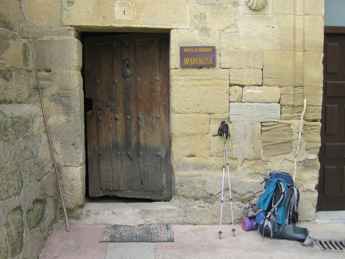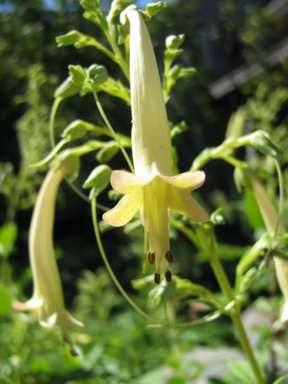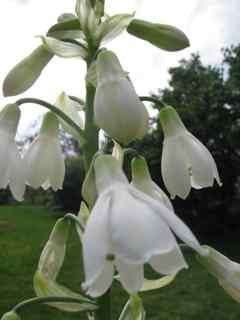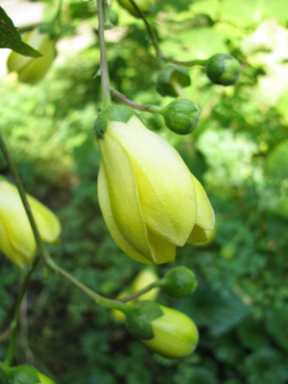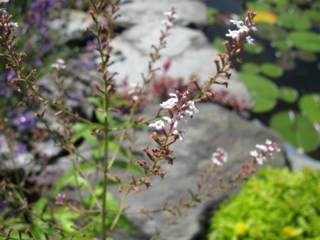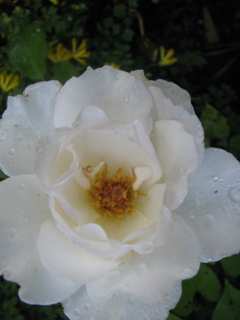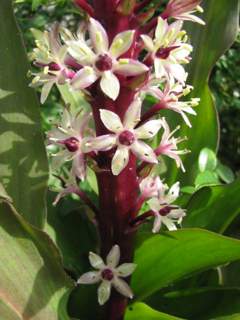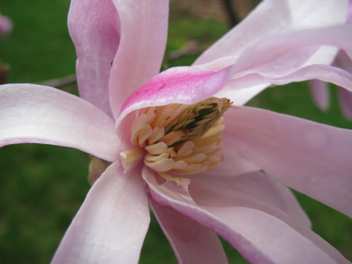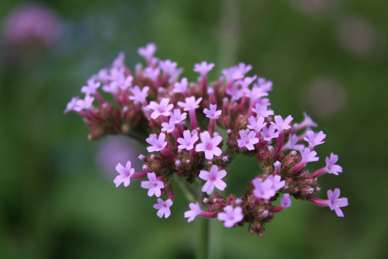I have asked Elizabeth to write about her third trip down the Camino- This is her first post about Camino Tres.

In late spring I felt the Camino calling me back for a third round, and once I hit Spanish soil two months later, there was no turning back. And that is when things fell apart. My two other treks had begun in June, but this time I began my Camino in July. Unbeknownst to me, this meant I was in a jam even before I got to the trail.
During my last Camino in 2009, I arrived in Madrid with my sights set on St Jean Pied de Port, the small French town that is the Camino headwater just over the Spanish border. And in 2009, the trail gods were with me. A high speed train took me to Pamplona and a taxi took me from there to St Jean Pied de Port. This time the story was filled with a looming specter that I had underestimated: the Running of the Bulls in Pamplona.
The Running of the Bulls made me a beginner again. The trains from Madrid to Pamplona were full with no tickets available. Madrid was buzzing with people all bent on going to Pamplona for the festivities, and I had no backup plan. I’d done this twice before, how could I feel like such a novice? How could I still be stumbling around like this was my first rodeo?
One metro ride, three lurching, lumbering slow trains and a taxi ride later I was in Pamplona but not yet to St Jean and the beginning of my journey. I haggled a posse of Americans from the train into letting me sleep on their floor, but somewhere to pass the dark hours was all I really got. Pamplona was alive all night, and herds of drunken revelers traipsed over me like rush hour traffic. I curled my back to the wall and wondered what rabbit hole I had fallen down.
Morning came and my taxi ride out of sunny Pamplona took me towards that familiar French town of St Jean and the starting gate I knew so well. As I left the old city of Pamplona, the streets were empty and the sun was creeping into all the dark corners of night soaked revelry. I sighed with relief to leave that trouble behind.
But a turn north proved more worrying. The Pyrenees were dark, not dark like night or even creeping dawn, but dark like weather, like soaked clouds of doom hanging around long after the sun had risen. There was no doubt about it. There were rainstorms in the mountains, and I had no protection against such a foe.
Back in the states, in a moment of temporary insanity, I had left my rain jacket at home. To be fair, it was 95 degrees as I meticulously packed my small cache of clothing into my pack, and my brother’s haunting notes about his Camino in July had send heat shivers across my skin. He said that nary a drop of rain fell in the 30 days he spent on the trail. The sun had been his ruthless companion, seeking him out with dehydration and sunburn in every waking moment. Being a New Englander by birth, I was a bit fearful of weather so hot that it crippled one’s ability to walk, because my primary job would once again be walking. So the rain jacket was forgotten. Better to carry a tube of sunscreen.
In other places, rain is annoying, but in the Pyrenees it feels dangerous, like an enemy suddenly lurking in the misty land ahead, one you can’t really play off as innocuous. I felt armor-less. Even a pathetic non-rainproof rain jacket like the one from my first Camino would have been welcome. At least I could have appeared to have a line of defense. My taxi driver turned down the American rock music and pointed out the obvious fact that it was raining in the mountains. Then he asked me if I had good gear for “very bad and unpredictable weather.†I nodded mutely and felt my pulse rising. I was unprepared. With over 1000 Camino miles under my belt, I was a beginner again.
After running around St. Jean Pied de Port like a crazy person in search of rain gear, I was at the edge of town covered in plastic. My backpack cover was (thankfully) in place so all the contents of my bag would be dry no matter what. My body though was still adjusting to the sheet of thick blue plastic curled around my torso, flaring out to my elbows in wide sleeves and spilling out to my knees like some open flap skirt. I now owned a poncho and needed to wear it too. Call it revenge for all my disparaging remarks in ‘The Trail’ in regards to this article of clothing. I was now officially eating crow.
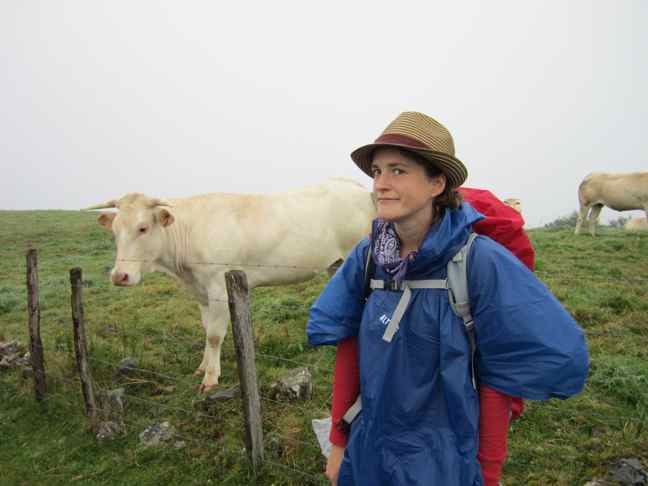
I’d become my own object of mockery. The rain enjoyed my costume and felt pleased enough to halt its deluge for a few hours. The sun even peeked its head around the distant peeks. I shoved the blue creature into my bag like a dirty secret and darted up the mountain for the first short day of walking to Orrison, the farthest I could go after my late start. I hoped the universe had laughed enough at me and my poncho and I would not be forced to wear it again. But I was a beginner again, and it seemed I was a bit of an unlucky one too.
The next morning dawned and after two Caminos of beautiful mountain crossings, I was greeted with walls of white and the smug sting of more rain. Not only would I have to wear my new poncho, but I would be caught in a tunnel of white for the rest of the day. Also my new shoes were doomed (because what’s the point of paying for the gorex waterproof kind right? Silly for July in Spain- extravagant even!).
That afternoon, when I arrived in Roncesvalles on the far side of the mountains, I was startled to once again be a newbie. The old monastery building that had housed pilgrims for as long as anyone could remember and had cradled me twice was closed. There was a new albergue, the Spanish word for pilgrim hostel, and it was as modern as they come. Impersonal cell blocks of bunks ringed each floor and the spaces for gathering were harshly lit and cavernous. This was new and jarring. Would there be anything familiar about this familiar journey?
In the days to come I would find the trail a place changed. Sometimes for the better as in the new influx of families walking the trail with their children. In the past, I had seen only a single child under the age of fourteen, and the one I had met looked bored and lonely in a world of adults. But with the change of season to the month of July, I was suddenly waiting for the sink behind a five year old on tippy toes and watching fathers lope by with baby carriers instead of backpacks. I even crossed paths with a family walking from France who had brought a donkey along with their three children, one of whom was not old enough to walk let alone amble down the trail. Many people I met talked about the joyful feeling of traveling alongside little pilgrims in warm family herds as well as the admiration they had for the pregnant woman walking the trail in her second trimester.
The Camino was suddenly blooming with life, and it was bliss to sit down at the end of the day and let it flow around me. I was happy to welcome such a sweet thread to the trail, happy to be a beginner with such pilgrims by my side. One of my most beloved companions deep in the journey was nine-year-old Martin who had been walking the trail in sections since he was six. He was more of a veteran than me but still willing to camp out on the floor by my bunk and help me practice my Spanish. Next year, he will go all the way to Santiago, and something tells me his time as a pilgrim has only begun.

But there were other currents of change and signs of unsettling shifts. These elements made me feel clumsy and distant from a trail I felt I knew so well. It was like returning to an old friend to find her changed in way that make her feel very, very far away. I was a beginner as I navigated the chaos of San Fermin and the Running of the Bulls in Pamplona, because even after traveling through it to get to the trailhead, I had to return to walk her streets three days later. I had always been at the far end of the trail, nearly five hundred miles away from the festival when it spilled its sticky, smelly, chaotic, dark energy all over the Camino. I would only see clips of the running on the TVs in bars, never seeing what lay beyond the two minute run of the bulls down the main street of the city. I was horrified enough, but the things that the cameras didn’t show were so much worse. There was death in the arenas and drunkenness in the middle of the morning, trash and unconscious people littering the streets, parks and church steps. Not a single surface was spared, not even the ancient trail. This time I would walk through Pamplona during the second day of the festival and the pain I felt for the Camino was acute. I had been so naïve. I was humbled to realize that the Camino had to endure this barage of darkness every year. I wondered if the ripple of toxic energy could be felt down the length the trail, like a living spine.
And I was a beginner in my own smaller realm. I had already betrayed the weakness in my packing skills but there were other cracks that showed how new this particular Camino was for me. Connecting to others, buying food, washing my clothes, packing my bag, waking up before dawn. All these elements felt strangely foreign. How could this be? I spent several days feeling dejected and unsettled by this strange new dance I was engaged in with the Camino. Where was that old familiar feeling?
And then I realized where the disconnect had begun. I’d thought I could pick up where I left off. I thought I could skip the introductions and just go back to being familiar. No need for a handshake or polite questions, I’d wanted to take off my shoes and curl up in the Camino’s arms like old times.
My last contact with the Camino was in Santiago after five hundred and fifty miles, and it had felt great. I was strong and familiar with the trail beneath my feet. We were close, closer than close. I had wanted to pick up the thread where I left off two years ago, but this was not the way the Camino or any living relationship works.
Now I was at the beginning again. There were awkward pauses and stilted attempts to connect. No way around it. I had to earn our closeness again. I had to listen. I needed to be present to the present, rather than caught up in the past. I spoke with several other Camino regulars (it is surprising how many return again and again to the trail), and we all agreed we felt a bit like people waiting to get our sea legs or waiting for a love one to recover from amnesia and embrace us again.
We all remembered how good it could be, how good it had been so the reality of the new relationship felt, well…. new and put a fresh panic in even the most seasoned vets eyes. We were old timers, so why did we have to put up with the business of being green again?
This question dogged me for many a hundred kilometer, but eventually I found solace in the silence of an empty early morning trail and realized that being a beginner was OK, healthy in fact. Some of the newness was great and some of it was rough but the two balanced each other out. I had already identified and festered over the negatives, but the positives seeped into me like thick morning dew into my non-waterproof sneakers, slowly but with a powerful impact.
To be a beginner was to be alive to the present. If this Camino was going to treat me like all the other newbies, then it was also going to hold my attention, smack me around a bit and show me what was happening right now for her and for those of us on her trail. I had eaten, breathed, dreamed and chronicled the Camino for so many years that I wanted to be with my old friend again, but my old friend was still alive and changing, facing new challenges to her integrity and bringing aboard new strengths. If I could be OK with feeling new, then she could use my help in coping with all the newness.
After that morning alone with the Camino, I felt I was still fumbling, but I wasn’t as lost. I was plugged back into the current challenges of a spiritual trail, even if I forgot to wear my hat and let my nose get burnt, or spilled my new fangled water bottle all down my leg. I was still learning, there was time to figure it all out.
